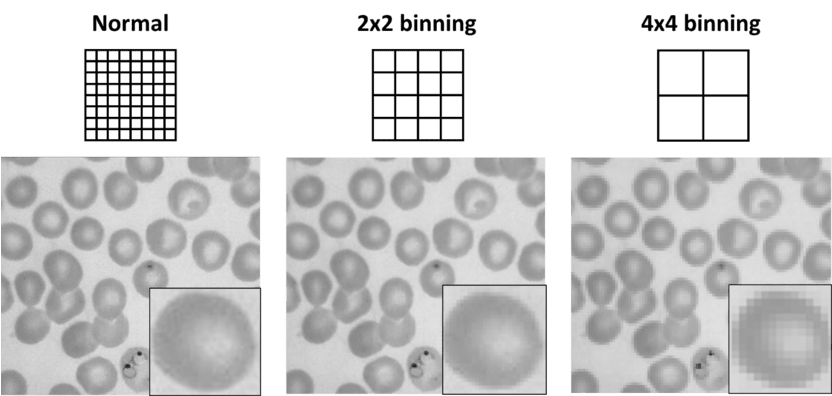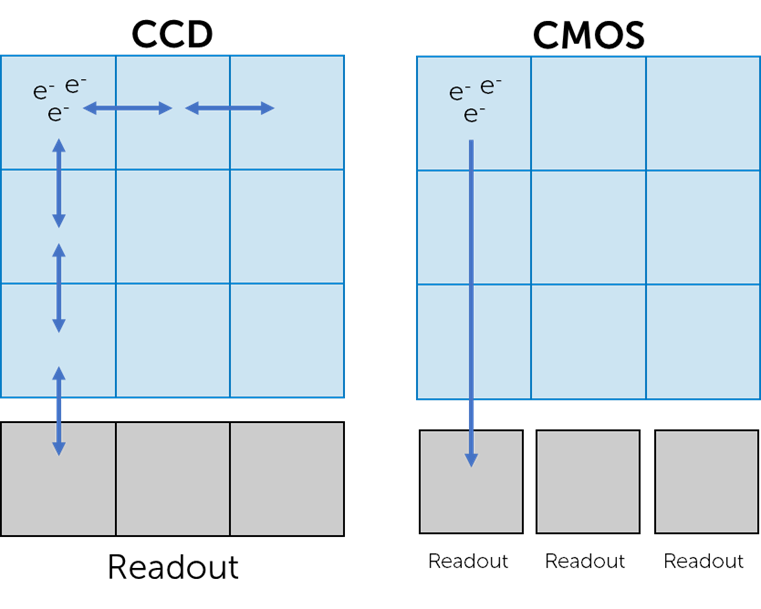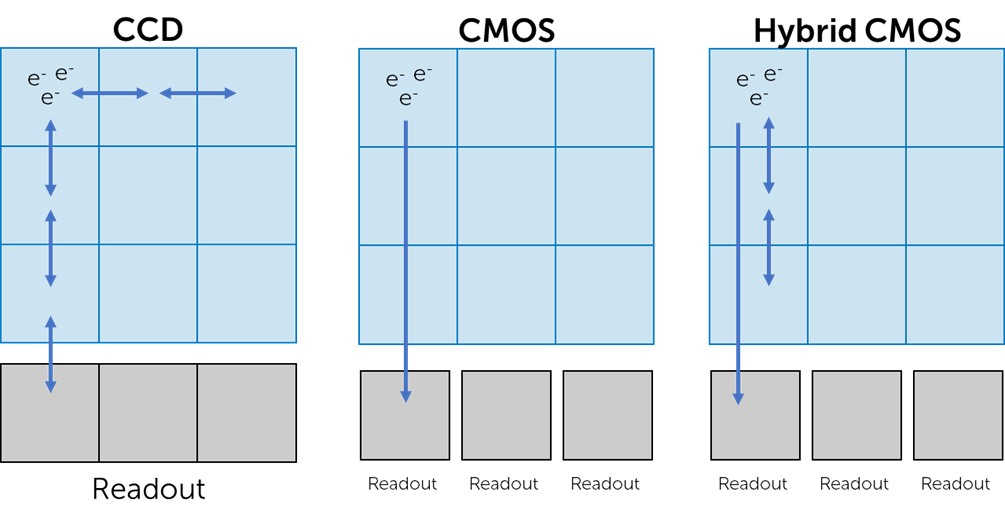Hybrid Binning
Introduction
The Retiga E7 CMOS camera has hybrid binning capabilities, combining the best of CCD and CMOS technologies. In this article we discuss binning, the benefits of binning, and how the hybrid binning of the Retiga E7 CMOS results in increases in both speed and signal-to-noise ratio (SNR), thanks to careful electronic design across the sensor.
While the effects of binning differ between CCD and CMOS, each affecting speed and sensitivity in a different manner, hybrid binning brings together the benefits of both modes to the Retiga E7 CMOS. Read on to see how it all works!

Binning
Binning is where multiple sets of pixels are combined into a 'superpixel', mostly in square grids of pixels like 2×2, 4×4 and so on. With a 2×2 bin, each 2×2 grid of pixels across the sensor is combined into a superpixel with four times the area. These larger superpixels can collect more signal from the sample (photons) and generate more noise, but the increase in signal is typically greater than the increase in noise, meaning that binning will increase camera sensitivity (greater SNR) but will also decrease resolution, as all pixels have become larger. An example of a 2×2 and 4×4 bin can be seen in Fig.1.

Normal image has a 8×8 pixel array (64 pixels) and is the highest resolution but lowest sensitivity. The 2×2 bin combines each 2×2 grid
into a pixel 4x the area, now the array only has 16 pixels, 4x the sensitivity but reduced resolution. The 4×4 bin results in a 4 pixel array
(16x the area) with further increased sensitivity but reduced image resolution.
An important factor to consider with binning is the difference between binning with CCD or CMOS sensors. In a CCD, photoelectrons of signal can be moved from pixel to pixel, so CCD 2×2 binning involves grouping all the electrons in a 2×2 grid and then reading out just that section as one, known as on-chip binning. In a typical CMOS, there is a readout node for every single column, meaning that photoelectrons cannot move from column to column and binning cannot occur on-chip. This means that CMOS binning occurs off-chip. The presence of a readout node for every column of the sensor allows CMOS cameras to acquire far faster, but it does mean that CMOS binning typically occurs digitally, after acquisition. This process is outlined in Fig.2.

Figure 2: Differences between CCD sensors vs CMOS sensors. On the left is CCD, photoelectrons of signal can be moved between sensor pixels.
Upon readout, signals are pulled down into a single readout node. On the right is CMOS, photoelectrons of signal are amplified by miniaturized
electrons on each sensor pixel, but this signal cannot move between columns. Upon readout, signals are pulled into a readout note for each column.
CMOS readout is far faster, but any binning occurs off-chip, while CCD binning occurs on-chip.
Binning Sensitivity: CMOS vs CCD
Binning occurs differently on cameras with a CCD sensor versus cameras with a CMOS sensor. Binning a CCD sensor occurs on-chip before readout, the electrons across all pixels to be binned are simply combined and then read out as usual. Moving accumulated signal from pixel to pixel in this manner is virtually noise free, so a 2×2 bin with a CCD increases the signal by a factor of 4 (the pixel is 4x the area) and the noise is unchanged, resulting in a 4x increase to SNR (4:1 signal to noise).
In a typical CMOS sensor, neighbouring pixels have no electrical connections and binning instead occurs off-chip after readout. This means that while CMOS binning increases signal collection, it also increases sensor read noise. For a 2×2 bin with a CMOS the signal increases by a factor of 4 (the pixel is 4x the area) and the noise increases by a factor of 2, resulting in a 2x increase to SNR (4:2 or 2:1 signal to noise).
So in this manner, binning increases camera sensitivity in both CCD and CMOS, but to a greater degree with CCD (4x SNR increase for CCD, 2x SNR increase for CMOS).
Binning Speed: CMOS vs CCD
Binning also has an effect on speed. Because binning with a CCD occurs before readout, combining pixels together results in less pixels to read out, meaning readout is faster and the camera can operate at a greater speed. Taking our Retiga R6 CCD as an example, the camera will run at 7 fps across the full sensor unbinned, and when binned 2×2 will run at 11 fps. This means that binning with CCDs increases both speed and sensitivity. With CCDs being a slow imaging technology, this increase in speed can be very useful.
With CMOS, as the binning occurs off-chip after readout, the camera is still reading out the same number of pixels, which means that binning has no effect on speed, and only increases sensitivity. However, CMOS cameras are far faster than CCD cameras to begin with, with the entry level Moment CMOS operating at 50 fps across the full sensor as standard.
Hybrid Binning
Hybrid binning offers the best of both worlds between CCD and CMOS binning. Hybrid CMOS sensors, such as the one in the Retiga E7 CMOS, have electric connections between pixels, typically along the same column. This provides CCD-like charge accumulation without extra noise for pixels in columns, only adding noise when combining with the adjacent row. With a hybrid 2×2 bin on the Retiga E7 CMOS, pixel columns are combined before readout (CCD style) and pixel rows are combined after readout (CMOS style). This provides the same 4x increase in signal as always, but now with less of a noise increase than typical CMOS, resulting in an overall 2.8x increase in SNR (compared to 2x in typical CMOS).
As well as a greater sensitivity increase than typical CMOS, hybrid sensors also receive a speed benefit from binning, similarly to CCD. With a 2×2 bin the Retiga E7 CMOS doubles in speed, meaning that it can acquire at 51 fps across the full frame unbinned, and 102 fps with a 2×2 bin. This increase in both speed and sensitivity mirrors a CCD bin, but with the much higher base speeds of a CMOS.
Overall, hybrid binning provides the best of both worlds, with all the advantages of CMOS with the on-chip binning of CCDs. The Retiga E7 CMOS brings hybrid binning to scientific cameras, promoting faster and more sensitive imaging across many applications.
 Figure 3: Differences between CCD, CMOS, and Hybrid CMOS sensors. In a hybrid CMOS sensor, there are electric connections between
Figure 3: Differences between CCD, CMOS, and Hybrid CMOS sensors. In a hybrid CMOS sensor, there are electric connections between pixels in a column (similar to a CCD), and each column has its own readout node (similar to a CMOS). This hybrid approach allows
for the fast readout of CMOS and the on-chip binning of CCD.
The direct speed benefits of hybrid binning can be seen in Table 1, which details the framerate (imaging acquisition speed) of the Retiga E7 CMOS in each mode:
| Mode | Unbinned Speed (fps) | 2×2 Bin Speed (fps) |
| Fast Capture | 51 | 102 |
| Long Exposure | 3.1 | 6.2 |
| Extended Dynamic Range (EDR) | 1.5 | 3 |
Summary
The Retiga E7 CMOS offers hybrid binning, which brings all the advantages of CCD binning to CMOS sensors. A 2×2 bin with the Retiga E7 will result in a 2.8x increase to sensitivity and a 2x increase to speed, making the Retiga E7 a powerful yet flexible solution for scientific imaging.